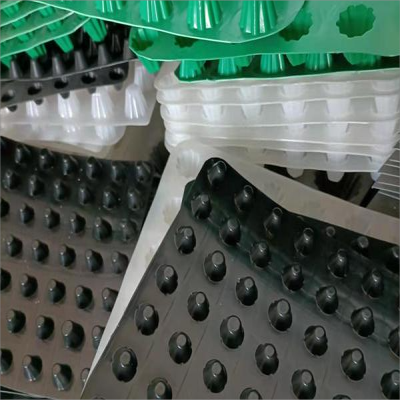1. Material selection and performance requirements
Plastic Drainage plate Is made of high density polyethylene ( HDPE) Or polypropylene ( PP) Made of high-strength, corrosion-resistant plastic raw materials. These materials not only have very good physical properties, such as high strength, high toughness, weather resistance and chemical stability, but also are easy to process and form, which can meet the needs of use under different engineering conditions. When selecting raw materials, it is necessary to ensure that the materials meet relevant national or industry standards, such as the “Technical Regulations for the Application of Plastic Drainage Boards for Water Transport Engineering”, etc., so as to ensure the quality and reliability of products.
2. Production process and quality control
The production process of plastic drainage board includes raw material preparation, extrusion molding, die pressing, cooling and solidification, cutting and trimming, and quality inspection. During the production process, the process parameters of each link must be strictly controlled to ensure the dimensional accuracy, drainage performance and durability of the product.
1、Preparation of raw materials: Select plastic raw materials that meet the requirements, and fully dry and mix them, so as to eliminate moisture and impurities in the raw materials and improve the quality and stability of products.
2、Extrusion molding: The mixed raw materials are fed into an extruder, melted by heating and then extruded. During the extrusion process, parameters such as extrusion temperature, pressure and speed should be strictly controlled to ensure the shape and dimensional accuracy of the product.
3、Mold pressing: An extruded plastic sheet is fed into a mold and pressed to form a drainage plate with a drainage groove. The mold should be designed and manufactured precisely, so as to ensure the drainage performance and dimensional accuracy of the product.
4、Cooling and solidification: The pressed drainage board is sent to the cooling chamber for cooling and solidification to eliminate the internal stress of the product and improve the stability of the product.
5、Cutting and trimming: The cooled and solidified drainage board is cut and trimmed to meet the needs of use under different engineering conditions. During the cutting process, it is necessary to ensure the flatness and smoothness of the cutting surface, so as to improve the aesthetics and durability of the product.
6、Quality inspection: Conduct quality inspection on the produced drainage board, including the inspection of appearance quality, dimensional accuracy, drainage performance, etc. Only products that meet the quality requirements can be sold out of the factory.
3. Construction specifications and operational requirements
Plastic drainage boards should strictly follow the relevant national or industry standards during construction to ensure the stability and durability of the project. During the construction process, pay attention to the following points:
1、Base layer treatment: Before construction, the base layer should be cleaned and leveled to ensure that the base layer is free of debris, water accumulation and the flatness meets the requirements.
2、Laying and fixing: Lay the drainage board according to the requirements of the design drawings, and use special fixing parts to fix it on the base layer. During the laying process, it is necessary to keep the flatness of the drainage board and the smoothness of the drainage groove.
3、Backfilling and compaction: After the drainage board is laid, backfilling and compaction should be carried out in time. Backfill materials should be made of materials such as gravel or gravel that meet the requirements, and the backfill thickness and compaction should be strictly controlled.
4、Inspection and acceptance: During and after the construction process, the quality inspection and acceptance of the drainage board should be carried out. The testing contents include testing of drainage performance, dimensional accuracy, fixing firmness, etc. Only projects that meet the quality requirements can pass the acceptance and be put into use.
Post time: Mar-04-2025




